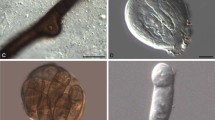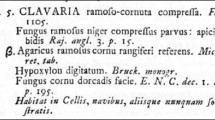Abstract
The genus Endohyalina is characterized by crustose, autonomous, or obligately lichenicolous thalli, lecideine apothecia with a hymenium often more or less inspersed with oil droplets and a brown hypothecium, Bacidia-type asci, small Dirinaria-type ascospores developing with type B ontogeny, bacilliform conidia and containing diploicin as the major secondary metabolite. The genus is based on four species previously included in Rinodina—R. ericina s. lat., R. insularis, R. interjecta and R. kalbii—and on two lichenicolous species from the Canary Islands described here as new, Endohyalina brandii and E. diederichii. The generic type, Endohyalina rappii, is reduced to synonymy with E. ericina whereas E. circumpallida is excluded from the genus and returned to Buellia s. lat. Except for the thalline growth form and the common lichenicolous habit, the diagnostic characters of Endohyalina are akin to those of Diploicia. New chemical data on Endohyalina insularis and E. kalbii are reported, and a simple method for determining the secondary chemistry of lichenicolous fungi is provided.


Similar content being viewed by others
References
Awasthi DD (1975) A monograph of the lichen genus Dirinaria. Bibl Lichenol 2:1–108
Bungartz F, Elix JA, Nash TH III (2004) The genus Buellia Sensu Lato in the Greater Sonoran Desert Region: saxicolous species with one-septate ascospores containing xanthones. Bryologist 107:459–479
Bungartz F, Nordin A, Grube U (2007) Buellia De Not. In: Nash TH III, Gries C, Bungartz F (eds) Lichen flora of the Greater Sonoran Desert Region, Vol. 3. Lichens Unlimited, Arizona State University, Tempe, pp 113–179
Crespo A, Blanco O, Llimona X, Fenencová Z, Hawksworth DL (2004) Coscinocladium, and overlooked endemic and monotypic Mediterranean lichen genus of the Physciaceae, reinstated by molecular phylogenetic analysis. Taxon 53:405–414
Elix JA, Jenkins GA, Lumbsch HT (1988) Chemical variation in the lichen genus Diploicia (Ascomycotina). Mycotaxon 33:457–466
Elix JA, Giralt M, Wardlaw JH (2003) New chloro-depsides from the lichen Dimelaena radiata. Bibl Lichenol 86:1–7
Gams W (2004) Report of the Committee for fungi: 11. Taxon 53:1067–1069
Giralt M (2000) The identity of Buellia ericina and its generic position. Lichenologist 32:309–316
Giralt M (2001) The lichen genera Rinodina and Rinodinella (lichenized Ascomycetes, Physciaceae) in the Iberian Peninsula. Bibl Lichenol 79:1–160
Giralt M, Llimona X (1997) The saxicolous species of the genera Rinodina and Rinodinella lacking spot test reactions in the Iberian Peninsula. Mycotaxon 62:175–224
Giralt M, Matzer M (1994) The corticolous species of the genus Rinodina with biatorine or lecideine apothecia in southern Europe and Macaronesia. Lichenologist 26:319–332
Giralt M, Nordin A (2002) Buellia triseptata in the Iberian Peninsula. Lichenologist 34:89–94
Giralt M, van den Boom PPG, Boqueras M (1996) Nuevas localidades para cinco especies del género Rinodina recientemente descritas o muy poco citadas. Folia Bot Misc 10:5–9
Giralt M, Paz-Bermúdez G, Elix JA (2009) New data on Sculptolumina japonica (Physciaceae). Bryologist 102:397–407
Hafellner J (1979) Karschia. Revision einer Sammelgattung an der Grenze von lichenisierten und nichlichenisierten Ascomyceten. Beihefte zur Nova Hedwigia 62:1–248
Hafellner J (2004) A further evolutionary lineage to lichenicolous growth in Physciaceae (Lecanorales). Bibl Lichenol 88:175–186
Hale ME Jr, Culberson WL (1956) A checklist of the lichens of the United States, Canada, and Alaska. Castanea 21:73–105
Harris RC (1988) Buellia in north and central Florida or the virtues and rewards of collecting. Evansia 5:37–45
Harris RC (1990) Some Florida lichens. Published by the author, Bronx, NY
Helms G, Friedl T, Rambold G (2003) Phylogenetic relationships of the Physciaceae inferred from rDNA sequence data and selected phenotypic characters. Mycologia 95:1078–1099
Imshaug HA (1951) The lichen-forming species of the genus Buellia occurring in the United States and Canada. DPhil Thesis, University of Michigan
Kalb K, Hafellner J (1992) Bemerkenswerte Flechten und lichenicole Pilze von der Insel Madeira. Herzogia 9:45–102
Kalb K, Elix J (2007) Diploicia A. Massal. In: Nash TH III, Gries C, Bungartz F (eds) Lichen flora of the Greater Sonoran Desert Region, Vol. 3. Lichens Unlimited, Arizona State University, Tempe, pp 226–227
Kaschik M (2006) Taxonomic studies on saxicolous species of the genus Rinodina (lichenized Ascomycetes, Physciaceae) in the Southern Hemisphere with emphasis in Australia and New Zealand. Bibl Lichenol 93:1–162
Magnusson AH (1954) A catalogue of the Hawaiian lichens. Arkiv Bot Ser 2,3(10):223–402
Marbach B (2000) Corticole und lignicole Arten der Flechtengattung Buellia sensu lato in den Subtropen und Tropen. Bibl Lichenol 74:1–384
Matzer M, Mayrhofer H, Rambold G (1997) Diploicia africana comb. nov. (lichenized Ascomycetes, Physciaceae), an endemic species from the Cape Province (South Africa). Nord J Bot 17:433–438
Matzer M, Mayrhofer H, Sattler J, Clerc Ph (1994) Rinodina canariensis (lichenized Ascomycetes, Physciaceae), a new species parasitic on crustose lichens in Macaronesia and the Mediterranean region. Nord J Bot 104:105–111
Mayrhofer H (1984) Die saxicolen Arten der Flechtengattungen Rinodina und Rinodinella in der Alten Welt. J Hattori Bot Lab 55:327–493
Mayrhofer H, Lambauer M (2004) Additional lichen records from New Zealand 41. Saxicolous and lichenicolous species of the genus Rinodina. Australasian Lichenology 54:28–32
Mayrhofer H, Moberg R (2002) Rinodina. Nordic Lichen Flora 2:41–69
Mayrhofer H, Poelt J (1979) Die saxicolen Arten der Flechtengattung Rinodina in Europa. Bibl Lichenol 12:1–186
Mayrhofer H, Scheidegger C, Sheard JW (1992) On the taxonomy of five saxicolous species of the genus Rinodina (lichenized Ascomycetes). Nord J Bot 12:451–459
Nimis PL (1993) The lichens of Italy. An annotated catalogue. Monografia XII. Torino, Museo Regionale di Scienze Naturali
Nordin A (2000) Taxonomy and phylogeny of Buellia species with pluriseptate spores (Lecanorales, Ascomycotina). Symbolae Botanicae Upsaliensis 33:1–117
Poelt J, Vĕzda A (1984) Rhizocarpon inimicum spec. nov. eine weitere parasitische Flechte auf Lecanora rupicola spec. coll. Herzogia 6:467–480
Rambold G, Triebel D (1992) The Inter-lecanoralean Associations. Bibl Lichenol 48:1–201
Rambold G, Mayrhofer H, Matzer M (1994) On the ascus types in the Physciaceae (Lecanorales). Plant Syst Evol 192:31–40
Rico VJ, Giralt M, Calatayud V (2003) Buellia tesserata and Dimelaena radiata, two closely related species. Lichenologist 35:117–124
Scheidegger C (1993) A revision of European saxicolous species of the genus Buellia de Not. and formerly included genera. Lichenologist 25:315–364
Sheard JW (2004) Rinodina (Ach.) Gray. In: Nash TH III, Ryan BD, Diederich P, Gries C, Bungartz F (eds) Lichen flora of the Greater Sonoran Desert Region, vol. 2. Lichens Unlimited, Arizona State University, Tempe, pp 467–502
Sheard JW, Lendemer JC, Tripp EA (2008) Buellia japonica (Physciaceae), a new lichen record for North America. Bryologist 111:124–127
Triebel D, Rambold G, Nash TH III (1991) On lichenicolous fungi from continental North America. Mycotaxon 42:263–296
Trinkaus U, Mayrhofer H (2000) Revision der Buellia epigaea-Gruppe (lichenisierte Ascomyceten, Physciaceae). I. Die Arten der Nordhemisphäre. Nova Hedwig 71:271–314
Trinkaus U, Mayrhofer H, Elix JA (2001) Revision of the Buellia epigaea-group (lichenized ascomycetes, Physciaceae) 2. The species in Australia. Lichenologist 33:47–62
Tuckerman E (1888) A synopsis of the North American lichens; Part II, comprising the Lecidei, and (in part) the Graphidacei. AnthonyNew Bedford
van den Boom PPG, Giralt M, Etayo J (2009) Notes on the lichen genus Rinodina (Physciaceae, Ascomycota) from the Canary Islands. Nova Hedwig 88:423–440
Wedin M, Baloch E, Grube M (2002) Parsimony analyses of mtSSU and nITS rDNA sequences reveal the natural relationships of the lichen families Physciaceae and Caliciaceae. Taxon 51:655–660
Acknowledgements
The authors are indebted to M. Brand, P. Diederich, K. Kalb, and the curators of BCN, G, and NY for the loan of material used in this study, and to H. Sipman and P. Diederich for their valuable comments on the manuscript and for correcting the Latin diagnoses. The first author thanks the “Comissionat per a la Recerca” (Catalan Government) for financial support.
Author information
Authors and Affiliations
Corresponding author
Rights and permissions
About this article
Cite this article
Giralt, M., van den Boom, P.P.G. & Elix, J.A. Endohyalina, the genus in the Physciaceae to accommodate the species of the Rinodina ericina-group. Mycol Progress 9, 37–48 (2010). https://doi.org/10.1007/s11557-009-0616-2
Received:
Revised:
Accepted:
Published:
Issue Date:
DOI: https://doi.org/10.1007/s11557-009-0616-2




